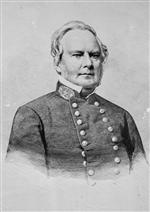Summary
 What exactly was Major-General Sterling Price trying to accomplish by attacking the Federal garrison at Fort Davidson? When General Kirby Smith had approved the raid into Missouri, he had listed the following objectives in his authorization order [145]
What exactly was Major-General Sterling Price trying to accomplish by attacking the Federal garrison at Fort Davidson? When General Kirby Smith had approved the raid into Missouri, he had listed the following objectives in his authorization order [145]
- Obtain recruits to fight for the Confederacy
- Capture St. Louis and it great stores of war supplies
- Destroy the state's infrastructure of railroads, bridge, telegraphs
- Capture as much of the state's mules, horses, cattle and military supplies
 In diverting his army to Pilot Knob, Major-General Sterling Price gave Federal Major-General William Rosecrans the time he needed to strengthen the defenses of St. Louis. It also gave Rosecrans additional time to mobilize his Federal Cavalry that was spread across the state. Once Rosecrans was certain that Price had entered southeastern Missouri, he ordered his cavalry from Springfield, Rolla, and Warrensburg to converge on Price's Army of Missouri.
In diverting his army to Pilot Knob, Major-General Sterling Price gave Federal Major-General William Rosecrans the time he needed to strengthen the defenses of St. Louis. It also gave Rosecrans additional time to mobilize his Federal Cavalry that was spread across the state. Once Rosecrans was certain that Price had entered southeastern Missouri, he ordered his cavalry from Springfield, Rolla, and Warrensburg to converge on Price's Army of Missouri.
Sterling Price was able capture vast quantities of military stores as his army moved across Missouri as he headed for Kansas. His wagon train eventually exceeded 500 wagons and stretched over eight miles. But this would also slow his movements down and eventually had to be abandoned in the retreat following the Battle of Westport.
Probably the main thing that Price's Missouri Raid accomplished was to divert Federal resources away from the Eastern Theater of the war. Major-General Andrew J. Smith's Sixteenth Army Corps was on its way to reinforce Major-General William T. Sherman's Atlanta Campaign, but was held up in Missouri to defend St. Louis. But Atlanta fell anyway, Abraham Lincoln was re-elected, and Sherman began his march to the sea.
 Although Price characterized the raid as a success, Major-General John B. Magruder, in command of the District of Arkansas, tells a different story in his report to General Kirby Smith. Price had brought back more bodies to an area that was already struggling to properly supply the men it already had. [146]
Although Price characterized the raid as a success, Major-General John B. Magruder, in command of the District of Arkansas, tells a different story in his report to General Kirby Smith. Price had brought back more bodies to an area that was already struggling to properly supply the men it already had. [146]
"Major-General Price has returned … with only about fifty wagons, and with fewer arms by 5,000 or 6,000 than he took with him. He has also with him, as I am informed, 4,000 or 5,000 recruits unarmed. Transportation must be supplied his army, and many thousand arms, say 10,000, are required to make this unarmed force of any use."
 Brigadier-General Jo Shelby was critical of the decision to attack Fort Davidson in a letter written and sent to Major C. C. Rainwater on January 5, 1888. [147]
Brigadier-General Jo Shelby was critical of the decision to attack Fort Davidson in a letter written and sent to Major C. C. Rainwater on January 5, 1888. [147]
"I favored moving rapidly into St. Louis and seizing it … to give the Southern element a chance to aid the South and the holy cause we had espoused. I then and there, at that conference, stated what the result would be if we attacked Pilot Knob. I could see nothing as an inducement; they had nothing we required. It would only cripple and retard our movements, and I knew too well that good infantry, well intrenched, would give us hell, and hell we did get. Besides, I did not care how much infantry was in our rear, the country was big and contained plenty of horses. What we wanted was men, and to reach St. Louis. We could have done it."
Back: Casualties
Next: Footnotes Pilot Knob
